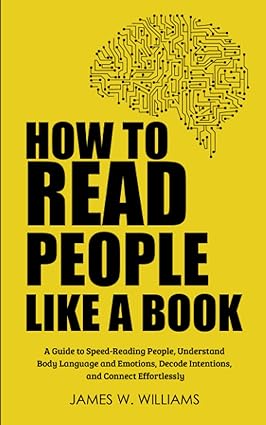This white paper explores the core concepts and practical applications of interpersonal perception, drawing inspiration from the premise of "reading people like a book." It delves into the nuances of body language, facial expressions, vocal cues, and psychological factors that influence human behavior, aiming to equip individuals with enhanced social awareness and interpersonal skills.
Reading People Like a Book: A Comprehensive Guide
This white paper explores the core concepts and practical applications of interpersonal perception, drawing inspiration from the premise of "reading people like a book." It delves into the nuances of body language, facial expressions, vocal cues, and psychological factors that influence human behavior, aiming to equip individuals with enhanced social awareness and interpersonal skills.
1. Introduction
Effective communication transcends the mere exchange of words. Understanding the underlying motivations, emotions, and intentions of others is crucial for building strong relationships, navigating social situations, and achieving personal and professional goals. This white paper explores the art of "reading people" – decoding nonverbal cues, understanding psychological principles, and developing heightened social awareness.
2. The Foundation: Nonverbal Communication
- Body Language:
- Posture: Open posture (uncrossing arms, leaning forward) often indicates openness and engagement. Closed posture (crossed arms, legs crossed) can suggest defensiveness or discomfort.
- Gestures: Hand gestures can convey emphasis, emotion, and underlying thoughts. Observe for consistency between verbal and nonverbal cues.
- Facial Expressions: Facial expressions are powerful indicators of emotions such as happiness, sadness, anger, fear, surprise, and disgust.
- Eye Contact: Sustained eye contact can indicate confidence, interest, or even dominance. Avoiding eye contact may suggest shyness, deceit, or discomfort.
- Vocal Cues:
- Tone of Voice: Variations in tone, pitch, and volume can convey emotions such as excitement, anger, sadness, or sarcasm.
- Pace of Speech: Rapid speech may indicate nervousness or excitement, while slow speech can suggest deliberation or boredom.
- Pauses and Hesitations: Pauses and hesitations can signal uncertainty, anxiety, or attempts to conceal information.
3. Understanding Psychological Factors
- Personality Traits: Recognize and understand different personality types (e.g., extroversion vs. introversion, agreeableness vs. antagonism) to better predict and interpret behavior.
- Motivations and Intentions: Analyze underlying motivations and intentions by observing behavior patterns, listening carefully to verbal cues, and considering the context of the interaction.
- Emotional Intelligence: Cultivate self-awareness and empathy to understand and respond effectively to the emotions of others.
- Cognitive Biases: Recognize common cognitive biases (e.g., confirmation bias, anchoring bias) that can influence our perceptions and interpretations of others.
4. Practical Applications
- Building Relationships: Develop stronger connections with colleagues, friends, and family by understanding their perspectives and emotional states.
- Negotiation and Persuasion: Identify and leverage nonverbal cues to influence negotiations and build consensus.
- Leadership: Effectively lead and motivate teams by understanding team dynamics, individual motivations, and communication styles.
- Customer Service: Provide excellent customer service by accurately assessing customer needs and emotions.
- Sales and Marketing: Tailor communication and marketing messages to resonate with the target audience.
- Personal Growth: Improve self-awareness and develop stronger interpersonal skills.
5. Ethical Considerations
- Respect for Privacy: Be mindful of privacy and avoid making assumptions or judgments based on limited observations.
- Cultural Sensitivity: Recognize that nonverbal cues and cultural norms vary across different cultures.
- Avoiding Stereotypes: Avoid making generalizations or assumptions based on stereotypes or biases.
- Ethical Use of Information: Use the insights gained from observing others responsibly and ethically.
6. References
- "The Definitive Book of Body Language" by Allan Pease and Barbara Pease
- "Emotional Intelligence 2.0" by Travis Bradberry and Jean Greaves
- "How to Win Friends and Influence People" by Dale Carnegie1
- "Crucial Conversations: Tools for Talking When Stakes Are High" by Kerry Patterson, Joseph Grenny, Ron McMillan, and Al Switzler2
- "Thinking, Fast and Slow" by Daniel Kahneman
- "Psychology Today" (website)
- "Harvard Business Review" (website)
7. Conclusion
"Reading people" is a valuable life skill that requires continuous learning and practice. By developing keen observational skills, understanding nonverbal cues, and cultivating empathy, individuals can enhance their interpersonal relationships, improve communication, and navigate social situations with greater confidence and effectiveness.
Disclaimer: This white paper provides a general overview of interpersonal perception and the art of "reading people." The information provided is for general knowledge and informational purposes only and should not be considered professional advice.
This information is for general knowledge and informational purposes only.
